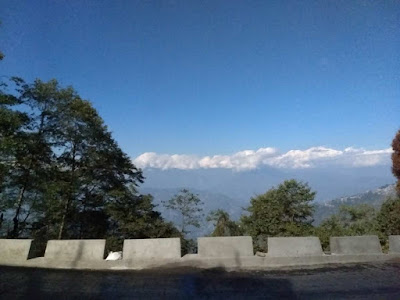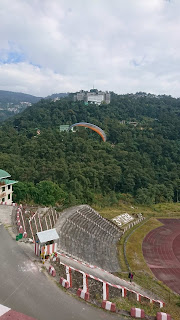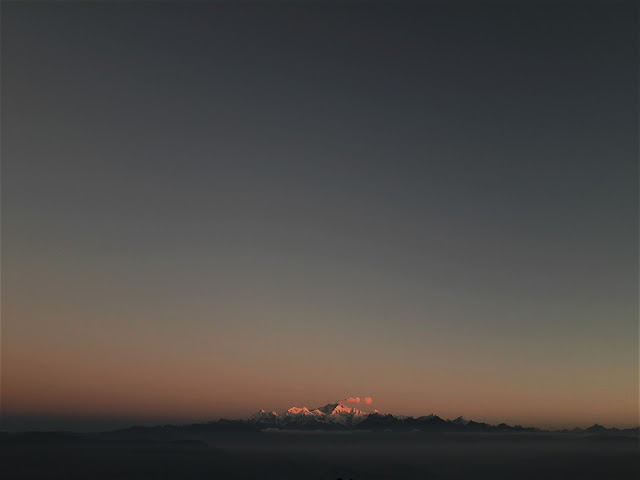Wandering along Kanchenjunga Day 7 Part 2
Day 7 Part 2
~~~ oOo ~~~
~~~ oOo ~~~
A walk for about 5-6 minutes from the main gate along a narrow road that first goes downhill and then uphill are the Japamese Temple and the Peace Pagoda. On the way you will notice a few small houses on the right with prayer flags fluttering in front of them. As you walk along, you come across a flight of stairs that lead to the Japanese Temple.
As you enter the temple, one comes across a statue of Buddha and a picture of the founder Fujii Guruji of 'Nipponzan Myohoji', a Buddhist order for world peace. He was a close associate of Mahatma Gandhi and had survived the Hiroshima and Nagasaki tragedy of atomic bomb explosion in 1945.
A flight of wooden stairs brings you to the prayer room. The prayer timings are from 4:30 a.m. to 6 a.m. in the morning and again from 4:30 p.m. to 6:30 p.m. in the evening. If you can time it right, you can also join the prayers and get an opportunity for introspection and feel the divine peace the temple offers. But we reached there at half past six and missed it.
Darjeeling Peace Pagoda is one of the Peace Pagoda designed to provide a focus for people of all races and creeds to help unite them in their search for world peace. Like most of the other Peace Pagodas, it was built under the guidance of Nichidatsu Fujii, a Buddhist monk from Japan and founder of the Nipponzan Myouhoji Buddhist Order.
According to the Lotus Sutra, the very appearance of the Peace Pagoda is an embodiment of Lord Buddha that radiates peace and non-violence. It purifies the land as well as the mind and the soul of the people.
While doing a 'Parikrama' (perambulation) around the pagoda at the pinnacle, beautiful artwork etched on sand stones that look like wooden work depicting the life of Buddha and his relics is seen. There are mythological depictions like 'Gift of Mango Grove by Amrapali at Vaishali' and 'Great departure of Siddhartha'.
While doing a 'Parikrama' (perambulation) around the pagoda at the pinnacle, beautiful artwork etched on sand stones that look like wooden work depicting the life of Buddha and his relics is seen. There are mythological depictions like 'Gift of Mango Grove by Amrapali at Vaishali' and 'Great departure of Siddhartha'.
It houses the four avatars of Buddha that includes Buddha's postures such as sitting, sleeping, standing and meditating. From the top of the Pagoda, you get a panoramic view of Darjeeling landscape including the Kanchenjunga range. The set of pictures taken in this complex were in relative brightness of the morning sky when the sun had not risen much above the range
~~~ oOo ~~~
Next on our list was the joy ride on the Toy Train...

Toy Train joy rides operate from Darjeeling Railway Station. It's a 2-hour jaunt, Darjeeling to Ghum round trip covering a total distance of 14kms. The train travels through the town cutting across busy areas parallel to the road. At times people stop in front of the shop in order the train to pass for them to come into the street.
 Ghum is the highest altitude station on the Darjeeling Himalayan Rail track. Ghum is at 2225.7 meters (7407 ft). Here the toy train stops for 30 minutes for a visit to Darjeeling Himalayan Railway Museum. The oldest toy train engine - The Baby Sivok is displayed.
Ghum is the highest altitude station on the Darjeeling Himalayan Rail track. Ghum is at 2225.7 meters (7407 ft). Here the toy train stops for 30 minutes for a visit to Darjeeling Himalayan Railway Museum. The oldest toy train engine - The Baby Sivok is displayed.
After Ghoom it stops for 10 minutes at the Batasia Loop.
Batasia Loop was commissioned in 1919 because it was an engineering requirement for the toy train to be able to handle a steep gradient. Just after Ghoom, there is a sharp fall as the toy train moves towards Darjeeling. There was no way the toy train could negotiate such a drastic fall of about 140ft unless there was a way to somehow reduce the gradient of the slope. To counter such a sharp slope, Batasia Loop was created.
 You won't even realize how the toy train actually descends by about 140 ft as it completes the loop through a large circular area and on a gentle slope and then crosses its own track near the beginning of the loop through a tunnel below. It is considered as one of the greatest engineering feats.
You won't even realize how the toy train actually descends by about 140 ft as it completes the loop through a large circular area and on a gentle slope and then crosses its own track near the beginning of the loop through a tunnel below. It is considered as one of the greatest engineering feats.
At Batasia the train makes a loop around a wonderful manicured garden. The view of Darjeeling town and the snow peaks of Kanchenjunga from here are unparalleled. This is the garden which houses the War Memorial that we had visited the previous day .
The steam engine train of course offers an authentic experience of the heritage and the colonial aura.
Darjeeling Himalayan Train is a World Heritage Site.. originally running from Darjeeling to Siliguri has been a lifeline since late 18oo's... It is a gift from the British era... It is a very innovative track system of that time as they beat the odds to set up this system in steam engines.. That is how it is still run in for city tour along with the option of diesel engine trips...

Toy Train joy rides operate from Darjeeling Railway Station. It's a 2-hour jaunt, Darjeeling to Ghum round trip covering a total distance of 14kms. The train travels through the town cutting across busy areas parallel to the road. At times people stop in front of the shop in order the train to pass for them to come into the street.
 Ghum is the highest altitude station on the Darjeeling Himalayan Rail track. Ghum is at 2225.7 meters (7407 ft). Here the toy train stops for 30 minutes for a visit to Darjeeling Himalayan Railway Museum. The oldest toy train engine - The Baby Sivok is displayed.
Ghum is the highest altitude station on the Darjeeling Himalayan Rail track. Ghum is at 2225.7 meters (7407 ft). Here the toy train stops for 30 minutes for a visit to Darjeeling Himalayan Railway Museum. The oldest toy train engine - The Baby Sivok is displayed. After Ghoom it stops for 10 minutes at the Batasia Loop.
Batasia Loop was commissioned in 1919 because it was an engineering requirement for the toy train to be able to handle a steep gradient. Just after Ghoom, there is a sharp fall as the toy train moves towards Darjeeling. There was no way the toy train could negotiate such a drastic fall of about 140ft unless there was a way to somehow reduce the gradient of the slope. To counter such a sharp slope, Batasia Loop was created.
 You won't even realize how the toy train actually descends by about 140 ft as it completes the loop through a large circular area and on a gentle slope and then crosses its own track near the beginning of the loop through a tunnel below. It is considered as one of the greatest engineering feats.
You won't even realize how the toy train actually descends by about 140 ft as it completes the loop through a large circular area and on a gentle slope and then crosses its own track near the beginning of the loop through a tunnel below. It is considered as one of the greatest engineering feats. The steam engine train of course offers an authentic experience of the heritage and the colonial aura.
It was a very pleasant journey... Indeed a joy ride.... We had an enjoyable time with a co-passenger kid imitating the engine whistle every time much to the embarrassment of parents but to the joy of the rest... That did send us down the memory lane of what our kids used to do and bringing with it a pleasant smile... and think... Those were the days!...
~~~ oOo ~~~













Comments
Post a Comment